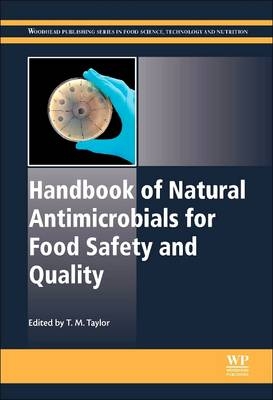
Handbook of Natural Antimicrobials for Food Safety and Quality
Woodhead Publishing Ltd (Verlag)
978-0-08-101399-1 (ISBN)
Dr Matt Taylor, Texas A&M University, USA
Related titles
List of contributors
Woodhead Publishing Series in Food Science, Technology and Nutrition
Preface
1. The use of natural antimicrobials in food: an overview
1.1. Introduction
1.2. Types of natural antimicrobials: animal sources
1.3. Types of natural antimicrobials: plant sources
1.4. Types of natural antimicrobials: microbial sources
1.5. Challenges to application of natural antimicrobials to foods
1.6. Application of natural antimicrobials
1.7. Conclusions
Part One. Types
2. Plant extracts as antimicrobials in food products: types
2.1. Introduction
2.2. Herbs, spices, and plant extracts as antimicrobials
2.3. Essential oils
2.4. Plant extracts in combination with minerals
2.5. Conclusion
3. Plant extracts as antimicrobials in food products: mechanisms of action, extraction methods, and applications
3.1. Introduction
3.2. Mechanisms of action of plant extracts
3.3. Plant extracts and antibiotic resistance
3.4. Extraction methods to maximize antimicrobial properties
3.5. Response of Gram-positive and Gram-negative bacteria to plant extracts
3.6. Applications of plant extracts in food products
3.7. Conclusion
4. Bacteriophages as antimicrobials in food products: history, biology and application
4.1. Introduction
4.2. Research into bacteriophages
4.3. Biology of bacteriophages
4.4. Bacteriophages as biocontrol agents in food
4.5. The use of phage endolysins as biocontrol agents in food
4.6. Combining bacteriophages with other preservation techniques to enhance food safety
5. Bacteriophages as antimicrobials in food products: applications against particular pathogens
5.1. Introduction
5.2. Bacteriophages to control Gram-negative food-borne pathogens
5.3. Bacteriophages to control Gram-positive food-borne pathogens
5.4. Conclusion and future trends
6. Lactic acid bacteria (LAB) as antimicrobials in food products: types and mechanisms of action
6.1. Introduction
6.2. Characteristics of lactic acid bacteria (LAB)
6.3. Carbohydrate metabolism in LAB
6.4. Effects of culture preparation and storage techniques on LAB
6.5. Antimicrobial compounds produced by LAB: organic acids, diacetyl, and hydrogen peroxide
6.6. Antimicrobial compounds produced by LAB: bacteriocins
6.7. Conclusions
7. Lactic acid bacteria (LAB) as antimicrobials in food products: analytical methods and applications
7.1. Introduction
7.2. Screening lactic acid bacteria (LAB) for antimicrobial activity
7.3. Regulatory framework governing the use of LAB in food
7.4. Methods for using LAB as biopreservatives in food
7.5. Use of LAB in the biopreservation of particular food products and as a biosanitizer
7.6. Conclusions
8. Chitosan as an antimicrobial in food products
8.1. Introduction
8.2. Overview of antimicrobial activity of chitosan
8.3. Mechanism of action
8.4. Effects of molecular structure
8.5. Effects of environmental conditions
8.6. Current applications and future trends
Part Two. Processing
9. Evaluating natural antimicrobials for use in food products
9.1. Introduction
9.2. The advantages of using antimicrobials in food preservation
9.3. The use of natural antimicrobials in food preservation
9.4. Combining antimicrobials with other preservation techniques
9.5. Factors affecting the biocidal activity of natural antimicrobials
9.6. The regulation of natural antimicrobials
9.7. Conclusion
10. Physical and chemical methods for food preservation using natural antimicrobials
10.1. Introduction
10.2. Physical application of natural antimicrobials
10.3. Chemical application of natural antimicrobials
10.4. Biological application of natural antimicrobials
10.5. Commercial natural antimicrobials
10.6. Conclusion and future trends
11. Nanostructured and nanoencapsulated natural antimicrobials for use in food products
11.1. Introduction
11.2. Natural food antimicrobials
11.3. Nanostructures for antimicrobial delivery
11.4. Methods for characterization of nanostructures
11.5. Food applications of nanostructured antimicrobial systems
11.6. Conclusions and future trends
12. Modelling the effects of natural antimicrobials as food preservatives
12.1. Introduction
12.2. Antimicrobial susceptibility assessment
12.3. Mathematical modelling in food preservation
12.4. Types of models
12.5. Model development
12.6. Modelling the effects of natural antimicrobial agents
12.7. Conclusion and future trends
Part Three. Using natural antimicrobials in particularfoods
13. Using natural antimicrobials to enhance the safety and quality of fresh and processed fruits and vegetables: types of antimicrobials
13.1. Introduction
13.2. Fresh and processed fruits and vegetables: advances and challenges
13.3. Natural antimicrobials used in assuring the safety and quality of fresh and processed fruits and vegetables: antimicrobials from plant essential oils
13.4. Antimicrobials from plants: aldehydes and methyl jasmonate
13.5. Antimicrobials from plants: phenolic compounds and isothiocyanates
13.6. Chitosan is not from plant origin
13.7. Natural antimicrobials of microbial origin: lactic acid bacteria (LAB) and bacteriocins
13.8. Conclusion and future trends
14. Using natural antimicrobials to enhance the safety and quality of fresh and processed fruits and vegetables: application techniques and quality issues
14.1. Introduction
14.2. Techniques for applying natural antimicrobials to fruits and vegetables: key issues
14.3. Encapsulation of natural antimicrobials
14.4. Edible films and coatings enriched with natural antimicrobials
14.5. Antioxidant properties of natural antimicrobials
14.6. Plant antimicrobials as flavoring compounds
14.7. Conclusion and future trends
15. Using natural antimicrobials to enhance the safety and quality of milk
15.1. Introduction
15.2. Enhancing the safety and quality of milk-based beverages using natural antimicrobials: milk
15.3. Enhancing the safety and quality of infant milk formulas using natural antimicrobials
15.4. Enhancing the safety and quality of egg–milk beverages using natural antimicrobials
15.5. Conclusion and future trends
16. Using natural antimicrobials to enhance the safety and quality of fruit- and vegetable-based beverages
16.1. Introduction
16.2. Enhancing the safety and quality of fruit- and vegetable-based beverages using natural antimicrobials
16.3. Melon and watermelon juices
16.4. Orange and orange-based juices
16.5. Grape juices
16.6. Apple and pear juices
16.7. Dark fruit juices
16.8. Tomato juices
16.9. Other vegetable beverages
16.10. Conclusion and future trends
17. Using natural antimicrobials to enhance the safety and quality of alcoholic and other beverages
17.1. Introduction
17.2. Alcoholic beverages
17.3. Wine
17.4. Beer
17.5. Apple cider
17.6. Hot drinks
17.7. Conclusion and future trends
18. Using natural antimicrobials to enhance the safety and quality of poultry
18.1. Introduction
18.2. Food safety and its role in food quality
18.3. Pre-harvest use of natural antimicrobials
18.4. Antimicrobials for use on poultry products
18.5. Conclusion and future trends
Index
| Erscheinungsdatum | 13.07.2016 |
|---|---|
| Reihe/Serie | Woodhead Publishing Series in Food Science, Technology and Nutrition |
| Verlagsort | Cambridge |
| Sprache | englisch |
| Maße | 152 x 229 mm |
| Gewicht | 590 g |
| Themenwelt | Sachbuch/Ratgeber ► Gesundheit / Leben / Psychologie ► Ernährung / Diät / Fasten |
| Technik ► Lebensmitteltechnologie | |
| ISBN-10 | 0-08-101399-X / 008101399X |
| ISBN-13 | 978-0-08-101399-1 / 9780081013991 |
| Zustand | Neuware |
| Haben Sie eine Frage zum Produkt? |
aus dem Bereich


